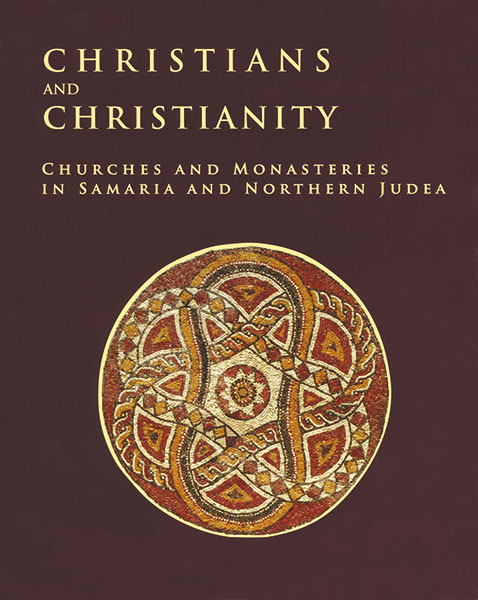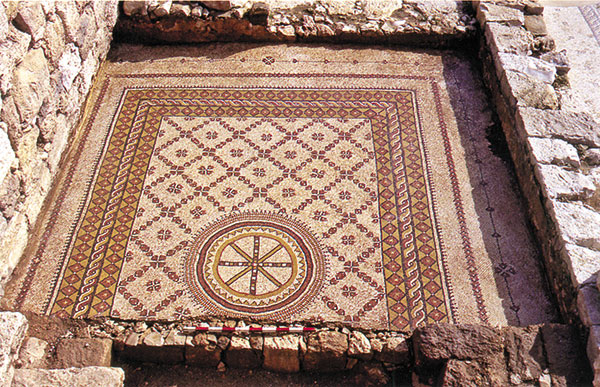ReViews: Ancient Christianity as Reflected in Its Churches

074
Christians and Christianity, Vol. III, Churches and Monasteries in Samaria and Northern Judea
Edited by Noga Carmin
(Jerusalem: Judea & Samaria Publications [Civil Administration of Judea & Samaria], Israel Antiquities Authority, 2012), xii + 498 pp., $62 (hardcover)
Christians and Christianity, Vol. IV, Churches and Monasteries in Judea
Edited by Noga Carmin
(Jerusalem: Judea & Samaria Publications [Civil Administration of Judea & Samaria], Israel Antiquities Authority, 2012), xiii + 506 pp., $62 (hardcover)
A surprisingly large number of Byzantine churches and monasteries have been discovered in the Holy Land during the last four decades. They include monumental pilgrimage churches erected in sanctified places, parish churches of various kinds and sizes, monastery churches and chapels. Taken together, they illuminate the various types of church construction, the development of Christian liturgy and the spread of Christianity in the Holy Land.
In these two bulky but beautifully illustrated volumes, the staff officer of archaeology in Judea and Samaria (the West Bank) has collected self-contained articles by 15 scholars, mostly archaeologists, epigraphists and numismatists, describing monasteries, churches and the late Roman fortresses that were converted into monasteries in the West Bank. Included are 27 sites: seven previous Roman fortresses, seven monasteries, eleven churches, one rock-cut tomb and a bathhouse.
The Roman fortresses that were later converted into monasteries were built between the fourth and fifth centuries within the most unstable regions of the Holy Land. (The local population still included many non-Christians, as well as sectarian Christians who had no special affection for the orthodox Christian authorities.) When the state became more secure in the sixth century during Justinian’s reign (527–565 C.E.), these fortresses became superfluous. During his 38-year reign Justinian secured the state both from outside threats and from internal political and religious uprisings (the Justinian Peace). At the same time, the Christian population in the Holy Land changed radically. Internal theological disputes, which in the previous two centuries had lacerated the Church, calmed down. This led to the rise of monasticism and its proliferation throughout the Holy Land. And secular structures, especially fortresses, were converted for monastic habitation and use.

The Islamic conquest of the Holy Land in 638 C.E. and the ensuing political and religious consequences created great difficulties in conventional Christian religious life and monastic practice, especially in the rural areas. Agrarian Christian settlement in the Holy Land dwindled to a minimum, and rural monasticism came almost to an end.
Most of the monasteries, both those established in preexisting structures and those built from scratch, are more or less rectangular in shape and consist of a central court, halls, rooms, various auxiliary spaces and agricultural installations, such as oil and wine presses. A church, either a basilica or a 075 076 simple one-room chapel, held a prominent place in the monastery.
The monks led a communal life and earned their living by the sweat of their brows. The monasteries were in fact monastery-farms, a phenomenon well-known and widely encountered in early eastern monasticism.
Both the community and monastery churches described in separate chapters of these volumes followed the usual basilical plan, differing only in size and structural complexity. The more splendid included a central nave, aisles, narthex and atrium. Some also had wings with chapels and liturgical rooms. Others included only a central nave, aisles and narthex.
The mosaics in the churches and chapels repeat the usual style, arrangement and decorative motifs. The two chapters in these volumes on mosaics are inter-related. One (“Mosaic Floors in Judea and Samaria” by Roni Amir) describes them, and the other (“Iconoclasm in Churches and Synagogues in Judea” by Yuval Peleg) describes their destruction by iconoclasts. The mosaics consist of rectangular carpets formed by geometric designs, interspersed with medallions. The medallions are usually filled with floral and animal patterns. Birds are also common in the medallions. In the most elaborate compositions, a vine-trellis from an amphora forms the medallions. Freestanding crosses and human figures are usually avoided (although there are exceptions, for example, at Khirbet Umm Deimine, which is not in this volume).
In the eighth century, figurative images, including birds and animals, were defaced in almost all the mosaic pavements.
Opposition to figurative depiction had been voiced by Christian theologians since the late third century, but only in the eighth century, in the reign of Leo II (717–741), did such opinions become more intensive and largely accepted to the point that the Council of Hieria (754 C.E.) pronounced the prohibition of figurative depiction part of church law.
At the same time, Islam embraced a similar policy but even more intensively. The defacement of figures in the churches described in these volumes was enforced not by the decisions of the Hieria council, which in fact were rejected by the Church of Jerusalem, but rather by sovereign Islam. The iconoclastic ideas and tendencies persisted in both Christianity and Islam in the second half of the first millennium. How Christians and Jews handled or, more correctly, how they implemented them involve complex issues. Although the seeds of iconoclasm are found in both Christianity and Judaism, the physical implementation of defacement by both Christians and Jews did not derive from their religious beliefs, nor did they enforce iconoclasm voluntarily. It was carried out, at least in the churches and synagogues in the Holy Land, under the pressure of sovereign Islam.
The mosaics discussed in these volumes also include inscriptions. Sixteen are presented in these volumes. All but one are in Greek. (The exception is in the Syro-Palestinian language and script, studied here by Moshe Bar-Asher.) The inscriptions are mostly dedicatory or memorial, mentioning or praising those 076 who initiated or financed the building or the mosaic. Some of the inscriptions bear a clear chronological indication, for example, mentioning the year of the emperor’s reign. Others are dated by the indictions (15-year cycles used as a time unit).
The patrons or beneficiaries mentioned are usually bishops, priests, deacons, laymen or the mosaic artist. The names (onomasticon) are Greek, Latin and Semitic, a probable indication of the demographic composition of the relevant population. For ten separate chapters, Leah Di Segni gives a scholarly and conclusive epigraphic study for each of the inscriptions.
Coins, pottery, glass and other finds are also treated in the various chapters—all in all quite a comprehensive coverage.
Of special note, the recently retired staff officer of the Civil Administration of Judea and Samaria, Yitzhak Magen, appears as author or an author in 13 of the chapters. Not far behind is his chief assistant, Yuval Peleg, who appears as an author in eight chapters.1
Although the churches and monasteries described in these volumes are extremely interesting, they do not present an integrated picture of the Christian activity in Judea and Samaria. They comprise more or less selective archaeological research, rather than a comprehensive geographical investigation. Still, they offer valuable historical and archaeological information on areas that to date have only been poorly researched.
Christians and Christianity, Vol. III, Churches and Monasteries in Samaria and Northern Judea
You have already read your free article for this month. Please join the BAS Library or become an All Access member of BAS to gain full access to this article and so much more.
